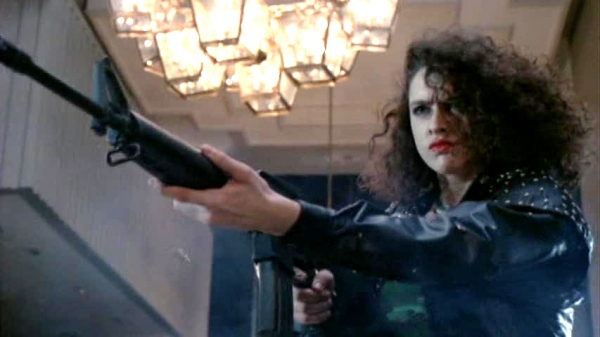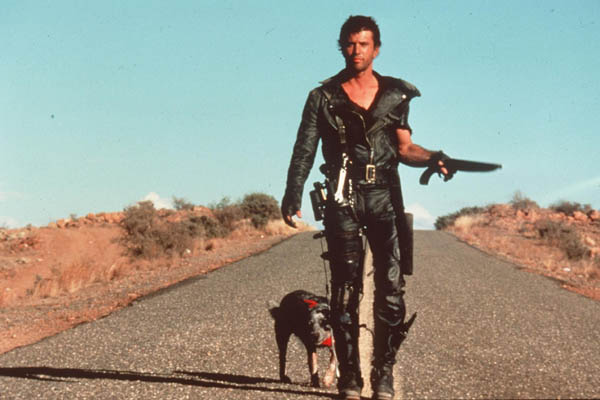 LADY TERMINATOR (1988); Dir: H. Tjut Djalil (aka Jalil Jackson); Starring: Barbara Anne Constable, Christopher J. Hart and Claudia Angelique Rademaker; Thurs. Nov 29, 9 p.m.; Cinefest Film Theatre; $5 (free for GSU faculty, students and staff with Panther ID); Trailer here.
LADY TERMINATOR (1988); Dir: H. Tjut Djalil (aka Jalil Jackson); Starring: Barbara Anne Constable, Christopher J. Hart and Claudia Angelique Rademaker; Thurs. Nov 29, 9 p.m.; Cinefest Film Theatre; $5 (free for GSU faculty, students and staff with Panther ID); Trailer here.
By Aleck Bennett
Contributing Writer
The last Thursday of every month brings something almost unexplainable to Cinefest Film Theare…something that approaches that fine line between “good” and “bad” and blows it to kingdom come.
Science fiction author Theodore Sturgeon once postulated something that has since become commonly known as “Sturgeon’s Law”: 90 percent of everything is crap. Few take this law to its logical conclusion, though: if 10 percent of everything is great, it stands to reason that 10 percent of the crap left over is really great crap.
Ladies and gentlemen, the 1988 Indonesian epic LADY TERMINATOR is some really great crap.
It’s hard to go wrong with any movie that opens with death by hoo-hah. I mean, that’s just science fact. By presenting you with this event right up front, LADY TERMINATOR is letting you know that anything can—and likely will—happen at any time. Before the opening credits hit, we not only see what happens to those who attempt to bed the woman known as the “South Sea Queen” and not satisfy her, we find out that the one man who does succeed at the task pulls an eel out of the mysterious woman’s…area…and turns said eel into a knife. This angers the temptress, which seems reasonable. She says that she will return in 100 years to seek revenge on his great-granddaughter, and then flees into the oceans’ depths to join with the forces of evil.
Like you do.
Fast forward 100 years, and a feisty young scientist named Tania (key quote: “I’m not a lady, I’m an anthropologist!”) comes to town to research the legend of the South Sea Queen. She takes a boat out to where the Queen’s castle supposedly collapsed into the ocean (it’s nowhere near shore, but why let this story be bound by little things like geography?), dives down to see if she can find the ruins, is magically transported to a bed in the middle of nowhere and tied down by sentient scarves, and the mysterious eel from earlier takes up new residence in a new…area. She emerges from the ocean possessed by the spirit of the South Sea Queen yet acting like Arnold Schwarzenegger in THE TERMINATOR, boinks a few random jerks, and proceeds to get on with the job of seeking vengeance by pursuing that previously mentioned granddaughter (who, naturally, happens to be a pop star).
From that point onward, the film is a non-stop barrage of gunfire, vehicles exploding, sex, blood, nudity, bad pop music, sub-John Carpenter synthesizer score, atrocious dubbing, ridiculous dialogue, popped-collar Polo shirts, inexplicable decision-making, goofy romance, jewelry mix-ups, uncalled-for hotel room eye surgery…and I think that the narrator from the TALES FROM THE DARKSIDE television series shows up. We’re never exactly told why the titular Lady Terminator acts like a cyborg, nor why she can’t be killed, nor why she can shoot laser beams out of her eyes and create electrical energy with her hands. Possession is a mysterious thing. Maybe it’s got something to do with those eels. Maybe they’re electric eels.
It’s hard to give this film any kind of critical analysis or review. It escapes logical exploration. It exists in a place beyond human reasoning. It stubbornly dares you to justify itself. And while it’s true that few movies have so little reason to exist, fewer deliver on the goods the way that LADY TERMINATOR does in its own remarkably wrongheaded way. It manages to effortlessly accomplish what any number of Troma Entertainment productions go out of their way to attempt, and without any of the “hey, we’re trying to make a bad movie here!” winking that you get from Troma’s output. It may not be accomplished on any level, objectively speaking, but it’s never boring in the least. It’s fun. It’s insanely entertaining. And, really, shouldn’t that be the standard by which it’s judged?
LADY TERMINATOR is crap. But it’s really great crap.
Aleck Bennett is a writer, blogger, pug warden, pop culture enthusiast, raconteur and bon vivant from the greater Atlanta area. Visit his blog at doctorsardonicus.wordpress.






